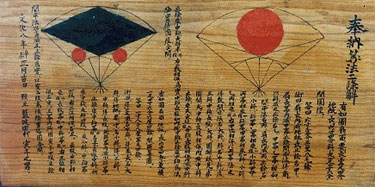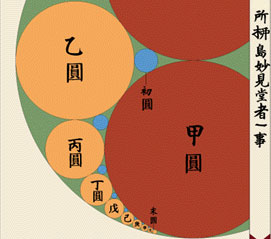

|
Japanese Temple Geometry Japanese Temple Geometry Problem
 During the Edo period (1603-1867) Japan was cut off from the western world. But learned poeple of all classes ,from farmers to samurai, produced theorems in Euclidean geometry. These theorems appeared as beautifully colored drawings on wooden tablets which were hung under one of the roof in the precincts of a shrine or temple.
The tablet was called a SANGAKU which means a mathematics tablet in Japanese. Many skilled geometers dedicated a SANGAKU in order to thank the god for the discovery of a theorem. The proof of the proposed theorem was rarely given. This was interpreted as a challenge to other geometers, "See if you can prove this." ----------
Japanese Temple Geometry
 Of the world's countless customs and traditions, perhaps none is as elegant, nor as beautiful, as the tradition of sangaku, Japanese temple geometry. From 1639 to 1854, Japan lived in strict, self-imposed isolation from the West. Access to all forms of occidental culture was suppressed, and the influx of Western scientific ideas was effectively curtailed. During this period of seclusion, a kind of native mathematics flourished.
Devotees of math, evidently samurai, merchants and farmers, would solve a wide variety of geometry problems, inscribe their efforts in delicately colored wooden tablets and hang the works under the roofs of religious buildings. These sangaku, a word that literally means mathematical tablet, may have been acts of homage--a thanks to a guiding spirit--or they may have been brazen challenges to other worshipers: Solve this one if you can! For the most part, sangaku deal with ordinary Euclidean geometry. But the problems are strikingly different from those found in a typical high school geometry course. Circles and ellipses play a far more prominent role than in Western problems: circles within ellipses, ellipses within circles. Some of the exercises are quite simple and could be solved by first-year students. Others are nearly impossible, and modern geometers invariably tackle them with advanced methods, including calculus and affine transformations. ----------
all three thanks to plep
Replies: 2 comments.
Can you help me with this precent problem?
If the radius of a circle is increased by 50%, the are is increasd by
Posted by Dmitry @ 07/11/2004 09:38 AM PST
HI HOW ARE YOU? I AM HARSH I WANT TO KNOW ABOUT THEORAMS AND RIADER.ETC PLEASE TELL ME ABOUT IT THANK YOU
Posted by HARSH AGRAWAL @ 07/07/2004 08:22 AM PST
|